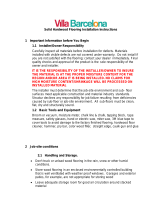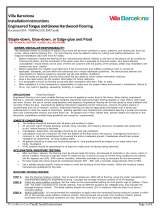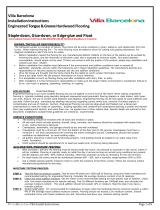
Page 1 of 10
Villa Barcelona
Installation Instructions
Engineered Hardwood HDF Flooring
Document ID#: VBHF062320_ENGHDF
FOR TECHNICAL SUPPORT, PLEASE CALL 800-758-9580
Products Included
Approved Grade Levels
Approved Installation Methods
All Engineered Hardwood
HDF
with click lock joints.
Above Grade.
On Grade.
Below Grade.
Primary Method: Floating.
Optional Method: Full Spread Glue.
Approved Grade Levels
Above Grade.
On Grade.
Below Grade
Owner/Installer Responsibility
The owner is advised to be at home during the installation for consultation/direction. The owner and installer should discuss
installation and
layout to maximize satisfaction. If this is not possible, consultation should be done prior to installation. Installers
should be familiar with
installation guidelines from National Wood Flooring Association (woodfloors.org).
The owner/installer assumes all responsibility for product quality of completed installation.
PERFORM PRE-INSTALL INSPECTION. FOR CLAIMS PURPOSES, YOU ARE ALLOWED TO OPEN UP TO 2 BOXES FOR PRODUCT INSPECTION. DO NOT
OPEN ALL
THE BOXES. OPENING ALL THE BOXES CONSTITUTES YOUR ACCEPTANCE OF THE PRODUCT. INSPECT ALL THE PLANKS IN THESE 4 BOXES
CAREFULLY.
EXAMINE FLOORING FOR COLOR, FINISH AND QUALITY. IF YOU DISCOVER THAT PRODUCTS ARE DEFECTIVE, OR IF MATERIAL IS
QUESTIONABLE, YOU
SHOULD CONTACT THE RETAILER. IF YOU ARE SATISFIED, PROCEED WITH INSTALLATION.
The length of the each plank in any box can vary from 12 inches to the maximum full length stated on the packaging or other product
descriptions. Each box can contain all full length boards or a combination of full length and shorter boards. There is no specific
percentage of
product length distribution.
Prior to installation, rack up planks from several boxes to ensure uniform distribution of colors, shades and characters in the installed
flooring.
Planks having similar widths should be placed together in the same row to minimize gaps between boards.
Wood floors are natural products containing natural variations. Variations in color, tone, grain, mineral streaks, small knots and other
characters are found from plank to plank. Similar variations exist between samples, pictures and purchased flooring. They are normal
and it
does not mean the product is defective.
Flooring to be installed in one large area should be purchased at the same time. Product purchased at a later time than the first
purchase
may vary beyond your expectations.
Accessories, trims and moldings are manufactured to coordinate with the varied appearances of the floor planks. Any exact matches
are
coincidental. Non-matching accessories are not defective products.
This product is manufactured according to strict quality standards. In the event that defects are discovered in the field, the
industry
standards permit a defect tolerance not to exceed 5%. The defects may be of any type, whether manufactured or
PROPOSITION 65 WARNING: This product contains chemicals known to the state of California to cause cancer
and/or
reproductive harm
CAUTION: ASBESTOS IN EXISTING FLOOR
Villa Barcelona product does not contain asbestos. Existing installed resilient flooring and asphaltic adhesive may contain asbestos
fillers
or crystalline silica. Do not sand, dry sweep, dry scrape, drill, saw, bead-blast, or mechanically chip or pulverize
existing resilient
flooring, backing, lining felt, asphaltic “cutback” adhesive or other adhesive. See “Recommended Work
Practices for Removal of
Resilient Floor Coverings” (rfci.com) for detailed information and instructions on removing all resilient
covering structures.
CAUTION: WOOD DUST
Sawing, sanding and machining wood products can produce wood dust. It can cause respiratory, skin and eye irritation. Avoid
prolonged
exposure to wood dust. Power tools should be equipped with a dust collector. If possible, perform wood dust
generating activities
outdoors. If high dust levels are encountered use an appropriate NIOSH-designated dust mask.

Page 2 of 10
natural. Order an
additional 5% extra for cutting wastage and grading allowances (10% for diagonal installations).
During installation, inspect the planks continuously. Defects that can be seen from a standing position should be cut off or held out.
Installing defective planks implies acceptance.
Squeaking and clicking noises are the result of interactions among flooring, joists and subfloors when they move. Limiting the
movements of
the flooring system usually eliminates most of these noises. Sometimes, it is impossible to eliminate them
completely and minor squeaking
or clicking noises are to be accepted as normal flooring phenomenon. Minor scratches can
generally be repaired with the use of putty, stain
or filler. It is an industry standard practice of flooring installation and it should be
accepted as normal by the homeowner.
To assure the warranty is not inadvertently voided, before proceeding with any activity that is not covered in this manual, please
contact our
Technical Support Department. Call Toll Free 800-758-9580
Acclimation and In-service Conditions
Acclimation is the process of adjusting (conditioning) the moisture content of hardwood flooring to the environment in which it is
expected
to perform. The hardwood flooring is fully acclimated when its moisture content and dimensions (width and length) are
stable. Engineered
hardwood flooring typically does not need acclimation as long as the environment it is being installed in is fully
acclimated. This means the
HVAC system is fully operational and the home is being maintained in lived in conditions during and after
the installation. If the temperature and relative humidity falls outside normal ranges of 60°F-80°F and relative humidity (RH) of 30%-
50% then the product must be acclimated for a minimum of 3 days or longer depending on conditions. T properly acclimate you
must open boxes, open plastic wrap.
Elevate cartons from the floor by placing them on 2”X 2” lumber or equivalence. Place spacers
(3/4” to 1” sticks) between each layer or
cross stack the layers for maximum exposure to ambient conditions. Acclimation
temperature range is 60°F-80°F and relative humidity (RH)
of 30%-50%. Conditions in which the floor was acclimated should be
maintained continuously thereafter. Document as much acclimation
information as possible below.
Date:
Relative Humidity (%):_
Temperature
(°F):
Subfloor Type:
Subfloor
Avg. Moisture Content (%):
Acclimation
Period:
Pre-acclimation Flooring Avg. Moisture
Content (%):
Pre-acclimation Flooring Width: _______
Pre-acclimation Flooring
Length:_______
Post-acclimation Flooring Avg. Moisture
Content (%):
Post-acclimation Flooring Width:
_____
Post-acclimation Flooring
Length: ____
Job Site Condition
Prior to installation, the installer must ensure that at the time of installation, the job site conditions including subfloor/substrate,
ambient
temperature and relative humidity, and all impacting variables will not negatively affect floor. Villa Barcelona will decline
responsibility for
damages associated with improper installation or poor site conditions.
Storage and Conditions
Do not store flooring in uncontrolled environmental conditions. For example, garages and exterior patios are not acceptable areas to
store
flooring. Handle and unload wood flooring with care and store within the environmentally controlled site in which it is
expected to perform.
Flooring stored on concrete slab should be elevated at least four inches to allow air circulation under cartons.
Existing Home
Existing home should have a consistent room temperature of 60°F-80°F and relative humidity (RH) of 30%-50%. Continual deviation
from
these conditions will affect the dimensions of flooring. During heating season, humidity may be much lower than the
acceptable range.
During heating season, a humidifier is recommended to prevent excess shrinkage flooring to low humidity levels.
During the non-heating
season, humidity levels can be maintained by using an air conditioner, dehumidifier, or by turning on your
heating system periodically.
New Construction or Remodel
All work involving water, such as pouring basement concrete floors, drywall and plasterwork, plumbing, etc. must be completed well
in
advance of the floor delivery. Ensure that the building is enclosed. Where building codes allow, permanent heating and/or air
conditioning
systems should be operating at least five days preceding installation to promote proper acclimation and should be
maintained during and after installation. If it is not possible for the permanent heating and/or air conditioning system to be
operating before, during and after installation, a temporary heating and/or dehumidification system that simulate normal living
(occupied) conditions can enable the installation to proceed until the permanent heating and/or air conditioning system is fully
operational.
Your job site should have a consistent temperature of 60°F-80°F and relative humidity (RH) of 30%-50% which should be maintained
continuously thereafter.

Page 3 of 10
Basements and Crawl Spaces
Concrete slab or ground must be dry. The ground in the crawl spaces must be completely covered using 6 mil black polyethylene.
Crawl
space clearance between the earth and underside of joists should be no less than 18 inches and the perimeter vent area
should be equal to 1.5% of the total square footage of the crawl space or as mandated by code.
Concrete Subfloor Requirements
It must have minimum rated strength of 3000 psi.
It must be flat. It should be flat to within 1/8” in a 6-foot span; no bumps or low spots. High spots can be removed by grinding;
depressions
can be filled with patching compound formulated for use in floor installation.
It must be clean; no construction debris, soil, mud and any other objects on/or adhering to the floor; if necessary, scrape and sweep
away
before the installation; no protrusions of nails, debris, metals should remain.
New concrete slab must cure for at least 60 days. It must have a minimum 10-mil polyethylene sheet between the ground and the
concrete.
It must meet concrete moisture requirement below.
It must be free from moisture related conditions which can damage the installed flooring.
Light Weight Concrete
It is concrete which rated strength is less than 3000 psi.
Perform a quick check by drawing a nail across the top; if it leaves indentation, it is probably light concrete.
For glue-down application, the concrete must possess shear strength greater than the glue. If concrete rated psi is unknown, contact
the
adhesive manufacturer for guidance.
Concrete Moisture
All concrete subfloors should be tested for moisture content and the results documented. Visual checks are not reliable. Perform tests
at
locations around exterior doorways, near walls containing plumbing, near foundation walls and in the center of the room.
Minimum sample
size is 3 per 1000 square feet of area and one test for every additional 1000 square feet thereafter.
Its moisture content should meet one of the following criteria below:
•
4.5% when tested using Tramex Concrete Moisture Encounter.
•
Less than 3 pounds per 1000 square feet per 24 hours when using Calcium Chloride test (ASTM F 1869).
•
75% when using Relative Humidity Testing (ASTM F-2170).
Please note: Concrete moisture content may be acceptable the time of the test but these tests do not guarantee a perpetual “dry”
concrete
slab. The concrete slab moisture content can vary at other times of the year. We are not responsible for moisture related
damage to installed
flooring.
Wood Subfloor Requirements
It must be clean; no presence of construction debris, soil, mud and any other objects on or adhering to the floor; no protrusions of
nails,
debris, metals should remain. If necessary, scrape and sweep the subfloor before the installation.
It must be structurally sound and stable: no movements or squeaks, no loose panels or loose nails, no signs of ply de-lamination or
other
damages. Repair all shortcomings before installation.
It must be flat with no visible bumps or low spots; the subfloor should be flat to within 1/8” in 6 feet span.
Test for moisture using reliable moisture meter. Perform tests at locations around exterior doorways, near foundation walls, near walls
containing plumbing lines and in the center of the room. Measure 20 locations per 1000 square feet.
Moisture content of subfloor should be less than 12%.
Moisture content difference between subfloor and acclimated flooring should be 4% or less.
Plywood or Oriented Strand Board (OSB) Specifications
On truss/joist spacing of 16” (406mm) O/C or less, the industry standard for single-panel subflooring is minimum 5/8” (19/32”, 15.1
mm) CD
Exposure 1 plywood subfloor panels (CD Exposure 1) or 23/32” OSB Exposure 1 subfloor panels, 4’ x 8' sheets. Expansion gap
between panels
should be 1/8” (3 mm). If panels are not tongued and grooved and there is not sufficient spacing or is inadequate, cut
in the required spacing
with a circular saw. Do not cut in expansion space on tongue and groove panels. If truss/joist spacing is 19.2"
apart then minimum thickness
of plywood or OSB panels is 23/32". If truss/joist spacing is larger than 19.2" apart then minimum
plywood thickness is 1" and minimum
thickness for OSB is 1.125". If the substrate does not meet these minimum guidelines then
add 1/2" of plywood to the substrate before
proceeding.
Particle Board or Fiber Board
Only for floating installation.

Page 4 of 10
Existing Floors
Installation over existing floor requires the installer to consider potential issues related to moisture damage, adhesive failure and
fastener
failure. Contact the adhesive and fastener manufacturers respectively for their specific instructions, recommendations and
requirements.
Acceptable floor coverings include: solid hardwood, linoleum, terrazzo, ceramic tile and other “moisture sealing
floors.”
Unacceptable floor coverings include: carpet, needle punch felt, edge glued linoleum and other “moisture absorbing flooring.”
Radiant Heated Subfloor
This product can be installed over radiant heated subfloor. Operating surface temperature must be less than 82°F. Decrease
temperature
before installation. Increase temperature gradually after installation. Glue down installation may require additional
installation requirement.
Contact glue manufacturer for specific recommendation. Contact heater manufacturer for specific
installation instruction.
Moisture Barrier and Moisture Retarder
Concrete Subfloor: For floating installation, use 6-mil polyethylene film or other means with equivalent permeability. Overlap the
edge
seams and tape it together. Extend moisture barrier up to the wall about 1 inch high. When installed on above grade concrete
and the
concrete moisture content meets the concrete moisture standard, a moisture barrier is not required. For direct glue
installation, use a
moisture barrier if moisture level exceeds requirement (see Concrete Moisture section above).
Wood Subfloor: Use asphalt-saturated paper or #15 or #30 felt that meets ASTM Standard D4869 or UU-B-790, Grade D.
Overlap along the edge seams 2”- 4” wide. This retards moisture movement from below.
Sound Control Underlayment
Check with sound control manufacturer for application guidelines. Generally, the less compressive underlayment is preferred.
Expansion Gap
Required gap width is 1/2”. It is required around the perimeter of the floor and between floor and all vertical obstructions. Do not
place
permanently installed structures such as kitchen counter/cabinet on the installed floor.
Transition Molding Floating installation, transition T-molding is required in the following cases: floor spanning greater than 35 feet in
length
or width; wall openings-with or without door.
Note: Floor areas interrupted by wall sections extending out of the wall; floor areas which are not rectangular may experience buckling
or
gapping if there is excessive floor expansion or shrinkage.
Adhesive
Use premium flooring adhesive which is non-water based, formulated for hardwood flooring installation.
Preferred type: moisture cure urethane floor glue.
Tools and Materials
Basics:
Tape measure • Moisture meter (wood, concrete or both) • Chalk line & chalk • Hammer • Electric power saw • Carbide tipped saw
blade for
fine cut • NIOSH-designated dust mask • Hand saw or jamb saw • Eye protection • Straight edge or Spacers • Pry Bar •
Mallet • Broom •
Color matched wood putty • Tapping block • Pull bar.
Additional Supplies for Glue-Down Method:
Flooring adhesive • Trowels • Adhesive remover for selected adhesive • Clean rags • Weight roller • 3M Blue tape.
Bond Failure
Bond failure is NOT flooring product defect. Most installation failures, including bond failure, result from jobsite moisture. Do not
unpack or
deliver flooring to the jobsite until moisture problems are corrected. Read adhesive manufacturer’s instruction carefully.
Certain wood
flooring adhesives may have special requirements and limitations of use. Some existing floor may not be acceptable.
Not following the
adhesive manufacturer’s recommendations can lead to installation failure or product damage and will void your
warranty.
Safety and Health Precautions
Power tools can be dangerous. Operate in strict accordance to manufacturer’s operating instructions and safety precautions.
Unsafe and
improper use can cause serious injuries.
Avoid inhalation and exposures to wood dust by mechanical means and by wearing personal protective equipment.
Wear appropriate personal protective equipment (PPE) which include NIOSH or OSHA approve dust masks, safety goggle and work
gloves.

Page 5 of 10
Glue Spots on Face of Finished Floor
Adhesive can damage the floor’s finish, especially when it has dried. It is extremely important to take precautionary steps NOT to leave
finger
prints or footprints marks on the face of the board. If glue comes in contact with the face of the board, remove immediately
with the adhesive remover recommended by the adhesive manufacturer. Use clean towels, changing frequently to prevent haze and
adhesive residue. If the spot removal damages the appearance of the boards, replace the board.
Helpful Pointers
General Tips
•
Make sure your work area is well lit. Good visibility ensures that color is consistent and that visually defective planks are
detected and
removed.
•
The minimum length of the first and last plank is 12”. If the last plank will be less than 12”, adjust the length of the first
plank. The
remainder of the last plank can be used as a starter board on the following rows.
•
Using a shorter piece at undercut door jams will help when fitting flooring in place.
Glue-Down Installation Tips
•
ALWAYS REFER TO THE SPECIFIC INSTRUCTIONS ON THE FLOORING ADHESIVE LABEL. The information given here is for typical
installation.
Adjust it according to adhesive manufacturer’s instruction.
•
Dry-lay means the glue has to set before placing floor planks in it. Wet-lay means the glue does not need to set before placing floor on
it.
•
Use trowel as specified by adhesive manufacturer.
•
Continuously check the transfer of adhesive THROUGHOUT the installation process. If the adhesive no longer transfers to the back
of the
flooring material, it must be removed and new adhesive applied.
•
Work your way out of the room.
•
After the installation is completed, keep the floor free from daily foot traffic for a minimum of 24 hours to allow adhesive to properly
cure.
Cutting the Last Row to Width
•
Most often the entire length of the last row will need to be cut so that it is narrow enough to fit the remaining space.
•
Measure the distance between the floor face edge (exclude the tongue) to the wall. Subtract ½” from this measurement for
expansion
gap. Draw a line. Cut through the line. Discard the excess piece. Proceed with installation.
Pre-Install Activities
•
Subfloors should be in clean condition.
•
Understand the parts of the locking part of the flooring plank. The tongue is the thinner extension coming out of the side of
the
planks. The groove is the wider extension coming out of the other side of the floor plank. The ends do not have tongue
and groove.
There is an upper drop-lock end on one side and a lower-drop lock end on the other side.
•
Lay out several cartons. Randomly rack planks to ensure good color and shade mixture and end joint spacing. Minimum end
stagger
is 6”. Inspect plank quality and grading.
•
Lay out trim moldings in advance and find planks whose shade closely matches. Set these aside for future use.
•
Remove existing base, shoe molding or threshold carefully. They can be used to cover the 1/2” expansion gap left around the
edge of
the room.
•
Undercut doors and casings using a handsaw laid flat on a piece of scrap flooring.
•
Install moisture barrier on concrete. For concrete, let the moisture barrier run up the wall a bit before cutting to size and
tape all
seams.
•
Install the underlayment (if used) according to underlayment manufacture instructions.

Page 6 of 10
FOR TECHNICAL SUPPORT, PLEASE CALL 800-758-9580
Floating Installation
Step 1 – Install the First Row
•
When possible, begin installation from the straightest wall. If possible, install the flooring perpendicular to the joists.
•
Cut off the tongue from the first row planks.
•
Allow 1/2” expansion gap between plank and the walls. Use spacers or board.
•
Place the first plank with the groove side facing away from the walls.
•
Place the upper drop-lock end of the second plank on the lower drop-lock end of the first plank. The ends do not click lock.
Maintain
straight edge along the rows.
•
Continue placing the succeeding planks to complete the row.
Step 2 – Install the Second and Remaining Rows
•
Cut off a section the first plank lengthwise to ensure 6” joints staggering.
•
Hold the plank with the tongue facing the previous row. Keep it at about 30° angle.
•
Insert the tongue into the groove.
•
Make sure the tongue are snuggly and securely engaged in the groove by exerting a constant pressure in the direction of the
groove.
•
Maintain the pressure while pressing the plank flat to lock the edge joints.
•
If there is a slight gap along the edge joints, it can be eliminated with the help of a tapping block and a plastic mallet. Use
caution to
prevent impact damage.

Page 7 of 10
Step 3 - Install the Last Row
•
Use the pull bar to draw the last row to fit tightly to the previous row.
Glue Down Installation
PLEASE NOTE:
ANY EXCESS GLUE WHICH GETS ONTO THE SURFACE OF THE FLOOR MUST BE REMOVED IMMEDIATELY WITH ADHESIVE REMOVER
The steps in glue down method are very similar to the floating installation method. The only difference is the application of the glue to
the
subfloor prior to installation. For more detail instruction, see the floating installation section above.
Step 1 – Set up
•
Cut off the tongue from the long edge of the boards for the first rows.
•
Ensure expansion gap by marking off a starting line 1/2” away from the starting wall. Mark off approximately 2 planks width
area to
spread glue.
Step 2 – Spreading the glue
•
Spread the glue from the starting line out in the direction of the center of the room, the width of two planks. Or spread only
enough
glue to install what can be set within 45 minutes (15 minutes of OPEN TIME and an additional 30 minutes for actual
installation.
Usually about two rows width coverage). Different manufacturer may require different open time and set time. Use
spacers or boards
to maintain expansion gap during installation.
•
Repeat with the next two rows, etc.
Step 3 – Install the first two rows
•
Install the first row of starter planks.
•
The last plank of the first row may have to be cut to size. Discard remainder because the tongue has been removed.
•
Install the second row. Make sure there is a random staggering at the end joints of at least 6” apart.
•
Be attentive to staggering the ends of the boards correctly in adjacent rows to avoid clustering end joints.
•
Any glue that comes in contact with the face of the board should be removed immediately using adhesive remover formulated
for the
glue being used. Follow adhesive manufacturer’s instruction on adhesive removal.

Page 8 of 10
FOR TECHNICAL SUPPORT, PLEASE CALL 800-758-9580
Finishing Touches
•
Clean the floor.
•
Use matching putty where necessary.
•
Install or reinstall all wall trim pieces. Nail them through the wall, but not to the subfloor to avoid restricting the expansion gap.
•
Install transition trim pieces. Nail them to the subfloor, not the flooring.
•
At doorways, transitions should be used to protect the edges of the floor and to provide a decorative transition from one floor
type to
another.
•
If the floor is to be covered, use a breathable material such as cardboard. Do not cover with plastic. Do not apply any tape to the
face of the product for protection or any other reasons. Finish damage that may occur is the responsibility of the person
applying the tape
and is not covered under terms of the warranty.
Step 4 – Install the remaining Rows
Spread another section of glue. Never spread more that can be covered before the adhesive is set. If adhesive is set and
will not transfer to the back of the plank, scrape off the adhesive and apply fresh adhesive.
Continue to install the next rows. Make sure there is a random staggering at the end joints of at least 6” apart.
Maintain 1/2” expansion gap between floor and the walls.
Repeat the process for additional rows.
Make sure that there is 100% contact between the wood floor and the adhesive.

Page 9 of 10
FOR TECHNICAL SUPPORT, PLEASE CALL 800-758-9580
Accessories
Pictures are for general illustrative purposes only. Actual products may differ from picture.
T-Molding is used to create a transition between floor coverings of similar heights or to
cover an
expansion gap.
Stair Nose is used in conjunction with flooring installed on stair steps or finished edge of a
higher
level floor like in a sunken living room.
Carpet Reducer (also called Baby Threshold or End Cap) is used to transition floor coverings
of
differing heights. This reducer strip is also commonly used to border a fireplace, sliding
glass door
and other exterior door jambs.
Hard Surface Reducer is used to transition to another hard surface flooring of different
heights
such as tile, vinyl, concrete.
Quarter Round is used to cover the expansion space between the Wall Base and your
flooring. It
can also be used them to make smooth transitions between the floor and
cabinetry. It can be used
with or without Wall Base molding.
Wall Base is used to give a finished look at the base of the walls. It can be used with or
without
Quarter Round.
Technical Support
For installation information and technical questions not covered in this installation guide, please contact our Technical Support
Representative by calling the toll free number below.
FOR TECHNICAL SUPPORT, PLEASE CALL 800-758-9580
Care and Maintenance
Daily Maintenance
1.
Sweep dust mop or vacuum your floor regularly to remove any particles that could cause abrasion or scratch your floor.
CAUTION:
Vacuums with a beater bar or power rotary brush head can damage a floor and should never be used.
2.
Apply appropriate cleaning solution to the cleaning cloth / mop. Use a cleaner specifically manufactured for hardwood flooring.
Do Not
Use Water or Vinegar. Do NOT apply directly to the floor.
•
For tougher spots, use a higher concentration of isopropyl alcohol and distilled water.
•
For extreme cases, a solution of nail polish remover (acetone) and distilled water can be used.
HINT: For best results, clean the floor in the same direction of the planks. When the cleaning cloth/mop becomes soiled, rinse or
replace it
with a clean one. Following up with a clean, dry cloth will remove residual streak marks and spots.
3.
Do NOT leave any amount of liquids (water, juice, soft drinks, spills, etc.) on the floor. Clean any wet spots immediately.

Page 10 of 10
4.
Do NOT use a steam cleaner.
5.
Do NOT use a wet mop or douse floor with water or liquid cleaners. Liquid can seep between the cracks and cause moisture damage.
6.
Do NOT use any cleaning agents containing wax, oil or polish. Left over residue will form a dull film.
7.
Do NOT use steel wool or scouring powder which will scratch the floor.
Branded or Off-the-shelf Floor Care Products
•
If none of the above are effective and you choose to use a store bought product, test the product in a non-conspicuous area (i.e.,
closet,
corner, or scrap pieces) for potential adverse side effects.
Preventative Maintenance
•
Protect your floor when using a dolly for moving furniture or appliances. Protective sheets and/or plywood may be needed. Never
slide
or roll heavy furniture or appliances across the floor.
•
Place protective pads beneath furniture legs and other heavy objects.
•
Avoid excessive exposure to water from being tracked in during periods of inclement weather.
•
Minimize abrasive material and dirt by placing mats on both sides of exterior doors and by using area rugs in high-traffic areas.
•
Rearrange furniture and rugs periodically to avoid uneven color and shade changes from light exposure.
•
Use protective mats beneath rolling chairs and keep furniture casters clean.
•
Keep pets’ nails trimmed.
•
Remove shoes with cleats, spikes or exceptionally pointy heels before walking on the floor.
Climate Maintenance
•
Care should be taken to control humidity levels within the 30% - 50% range. Hardwood flooring can be affected by varying
levels of
humidity.
•
Dry Climates: A humidifier is recommended to maintain humidity levels. Wood stoves and electric heat tend to create
very dry
conditions during the winter months this also will cause shrinkage in flooring.
•
Humid, Wet Climates: By using an air conditioner, heater, or dehumidifier proper humidity levels can be maintained to
prevent
excessive expansion due to high moisture content.
Floor Repair
•
Very light and small surface scratches can be repaired with a staining “touch up” pen of the appropriate color.
•
Slightly deeper scratches can be repaired by means of colored putty and or stains. Fill the scratches with the putty. Level with
putty
knife. Wipe off excess putty.
•
Very deep scratches may require the replacement of the planks.
FOR TECHNICAL SUPPORT, PLEASE CALL 800-758-9580.
-
 1
1
-
 2
2
-
 3
3
-
 4
4
-
 5
5
-
 6
6
-
 7
7
-
 8
8
-
 9
9
-
 10
10
Villa Barcelona LOWMRCL210EH Installation guide
- Type
- Installation guide
- This manual is also suitable for
Ask a question and I''ll find the answer in the document
Finding information in a document is now easier with AI
Related papers
Other documents
-
GREENWOOD LOA2496MJA-RH User manual
-
Home Decorators Collection HL618S Installation guide
-
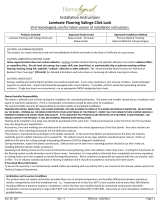 Home Legend HL1057 Installation guide
Home Legend HL1057 Installation guide
-
Malibu Wide Plank HDMRCL234EFP Installation guide
-
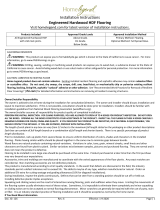 Home Legend HL196H Installation guide
Home Legend HL196H Installation guide
-
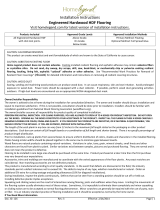 Home Legend HL154H Installation guide
Home Legend HL154H Installation guide
-
HOMELEGEND HL189H Installation guide
-
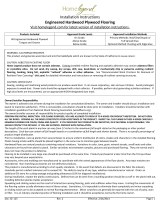 Home Legend HL65P Installation guide
Home Legend HL65P Installation guide
-
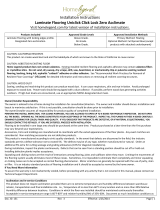 Home Legend HL1010 Installation guide
Home Legend HL1010 Installation guide
-
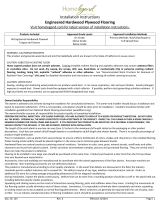 HOMELEGEND HL16P Installation guide
HOMELEGEND HL16P Installation guide











